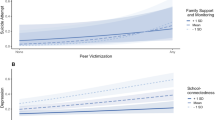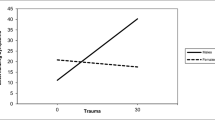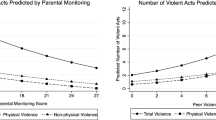Abstract
Secondary exposure to community violence is particularly detrimental for male youths, who disproportionately report witnessing community violence and suffering associated trauma-related symptoms. Yet, few studies have investigated whether parents perceive and report similar gender disparities among youths. In addition, few studies have examined the potentially negative effects of parent–child discord as to the youth’s level of exposure to violence, or whether these effects vary across gender. Therefore, this study investigated whether differences between parents’ and youths’ reports of youths’ exposure to violence, and the consequences of such reporting discord, varied across the gender of the youth informant. Participants were adolescents aged approximately 12 and 15 years at baseline (N = 1,517; 51 % female). Descriptive analyses indicated that male youths reported significantly higher levels of exposure to violence than female youths, but parents similarly under-reported their male and female children’s experiences with violence. Hierarchical analyses indicated that parental underestimation of youths’ exposure to violence had negative consequences. Moreover, significant interaction effects demonstrated that only females responded to reporting discord with internalizing problems. Conversely, both male and female youths responded to reporting discord with externalizing problems and offending. The results suggest that while parent–child discord is associated with negative outcomes for both male and female youths, discord may be disproportionately associated with negative outcomes among young females. The findings speak to the utility of examining the correlates and consequences of exposure to violence from a “gendered” perspective.
Similar content being viewed by others
References
Achenbach, T. M. (1991). Manual for the youth self-report and 1991 profile. Burlington, VT: University of Vermont, Department of Psychiatry.
Achenbach, T. M., McConaughy, S. H., & Howell, C. T. (1987). Child/adolescent behavioral and emotional problems: Implications of cross-informant correlations for situational specificity. Psychological Bulletin, 101, 213–232.
Acock, A. C. (2005). Working with missing values. Journal of Marriage and Family, 67, 1012–1028.
Allison, P. D. (2002). Missing data. Thousand Oaks, CA: Sage.
Bailey, D., & Garralda, M. E. (1990). Life events: Children’s reports. Social Psychiatry and Psychiatric Epidemiology, 25, 283–288.
Baron, R. M., & Kenny, D. A. (1986). The moderator-mediator variable distinction in social psychological research: Conceptual, strategic, and statistical considerations. Journal of Personality and Social Psychology, 51, 1173–1182.
Bell, C., & Jenkins, E. (1993). Community violence and children on Chicago’s south side. Psychiatry: Interpersonal and Biological Processes, 56, 46–54.
Block, J. (1984). Sex role identity and ego development. San Francisco: Jossey-Bass.
Borawski, E. A., Ievers-Landis, C. E., Lovegreen, L. D., & Trapl, E. S. (2003). Parental monitoring, negotiated unsupervised time, and parental trust: The role of perceived parenting practices in adolescent health risk behaviors. Journal of Adolescent Health, 33, 60–70.
Boxer, P., Morris, A. S., Terranova, A. M., Kithakye, M., Savoy, S. C., & McFaul, A. F. (2008). Coping with exposure to violence: Relations to emotional symptoms and aggression in three urban samples. Journal of Child and Family Studies, 17, 881–893.
Buka, S. L., Stichick, T. L., Birdthistle, I., & Earls, F. J. (2001). Youth exposure to violence: Prevalence, risks, and consequences. American Journal of Orthopsychiatry, 71, 298–310.
Caldwell, B., & Bradley, R. (1985). Home observation for measurement of the environment (HOME)—Revised edition. Little Rock: University of Arkansas.
Carmen, E. H., Rieker, P. R., & Mills, T. (1984). Victims of violence and psychiatric illness. American Journal of Psychiatry, 14, 378–383.
Carter, R. S., & Wojtkiewicz, R. A. (2000). Parental involvement with adolescents’ education: Do daughters or sons get more help? Adolescence, 35, 29–44.
Ceballo, R., Dahl, T. A., Aretakis, M. T., & Ramirez, C. (2001). Inner-city children’s exposure to community violence: How much do parents know? Journal of Marriage and Family, 63, 927–940.
Centers for Disease Control and Prevention. (2006). Preventing youth violence. Retrieved from http://www.cdc.gov/ncipc/pubres/research_agenda/09_youthviolence.html.
Daly, K. (1998). Gender, crime, and criminology. In M. Tonry (Ed.), The handbook of crime and punishment (pp. 85–108). Oxford: Oxford University Press.
Dishion, T. J., & McMahon, R. J. (1998). Parental monitoring and the prevention of child and adolescent problem behavior: A conceptual and empirical formulation. Clinical Child and Family Psychology Review, 1, 61–75.
Dodge, K., Bates, J., & Petit, G. (1990). Mechanisms in the cycle of violence. Science, 250, 1678–1683.
Eccles, J. S., Jacobs, J. E., & Harold, R. D. (1990). Gender role stereotypes, expectancy effects, and parents’ socialization of gender differences. Journal of Social Issues, 46, 183–201.
Eitle, D., & Turner, R. J. (2002). Exposure to community violence and young adult crime: The effects of witnessing violence, traumatic victimization and other stressful life events. Journal of Research in Crime and Delinquency, 39, 214–237.
Eunice Kennedy Shriver National Institute of Child Health and Human Development. (2002). Workshop on children exposed to violence: Current status, gaps, and research priorities. Washington, DC: U.S. Government Printing Office.
Farrell, A., & Bruce, S. (1997). Impact of exposure to community violence on violent behavior and emotional distress among urban adolescents. Journal of Clinical Child Psychology, 26, 2–14.
Feinberg, M., Howe, G. W., Reiss, D., & Hetherington, E. M. (2000). Parent–child perceptual differences and adolescent adjustment. Journal of Family Psychology, 14, 531–555.
Feinberg, M., Neiderhiser, J., Howe, G., & Hetherington, E. M. (2001). Adolescent, parent, and observer perceptions of parenting: Genetic and environmental influences in shared and distinct perceptions. Child Development, 72, 1266–1284.
Finkelhor, D., Turner, H., Ormrod, R., & Hamby, S. L. (2009a). Children’s exposure to violence: A comprehensive national survey. Bulletin. Washington, DC: U.S. Department of Justice, Office of Justice Programs, Office of Juvenile Justice and Delinquency Prevention.
Finkelhor, D., Turner, H., Ormrod, R., & Hamby, S. L. (2009b). Violence, abuse, and crime exposure in a national sample of children and youth. Pediatrics, 124, 1411–1423.
Fitzpatrick, K. M., & Boldizar, J. (1993). The prevalence and consequences of exposure to violence among African-American youth. Journal of the American Academy of Child and Adolescent Psychiatry, 32, 424–430.
Fitzpatrick, K. M., Piko, B. F., Wright, D. R., & LaGory, M. (2005). Depressive symptomatology, exposure to violence, and the role of social capital among African American adolescents. American Journal of Orthopsychiarty, 75, 262–274.
Foster, J. D., Kuperminc, G. P., & Price, A. W. (2004). Gender differences in posttraumatic stress and related symptoms among inner-city minority youth exposed to community violence. Journal of Youth and Adolescence, 33, 59–69.
Fowler, P. J., Tompsett, C. J., Braciszewski, J. M., Jacques-Tiura, A. J., & Baltes, B. B. (2009). Community violence: A meta-analysis on the effect of exposure and mental health outcomes of children and adolescents. Development and Psychopathology, 21, 227–259.
Gardner, M., & Brooks-Gunn, J. (2009). Adolescents’ exposure to community violence: Are neighborhood youth organizations protective? Journal of Community Psychology, 37, 505–525.
Gibson, C. L., Morris, S. Z., & Beaver, K. M. (2009). Secondary exposure to violence during childhood and adolescence: Does neighborhood context matter? Justice Quarterly, 26, 30–57.
Gladstein, J., Rusonis, E. S., & Heald, F. P. (1992). A comparison of inner-city and upper-middle class youths’ exposure to violence. Journal of Adolescent Health, 13, 275–280.
Goodman, K. L., De Los Reyes, A., & Bradshaw, C. P. (2010). Understanding and using informants’ reporting discrepancies of youth victimization: A conceptual model and recommendations for future research. Clinical Child and Family Psychological Review, 13, 366–383.
Gorman-Smith, D., Henry, D. B., & Tolan, P. H. (2004). Exposure to community violence and violence perpetration: The protective effects of family functioning. Journal of Child Clinical and Adolescent Psychology, 33, 439–449.
Hanson, R. F., Borntrager, C., Self-Brown, S., Dilpatrick, D. G., Saunders, B. E., Resnick, H. S., et al. (2008). Relations among gender, exposure to violence, and mental health: The National Survey of Adolescents. American Journal of Orthopsychiatry, 78, 313–321.
Hardy, D. F., Power, T. G., & Jaedicke, S. (1993). Examining the relation of parenting to children’s coping with everyday stress. Child Development, 64, 1829–1841.
Hill, H. M., & Jones, L. P. (1997). Children’s and parents’ perceptions of children’s exposure to violence in urban neighborhoods. Journal of National Med Association, 89, 270–276.
Howard, D. E., Cross, S. I., Li, X., & Huang, W. (1999). Parent–youth concordance regarding exposure to violence: Relationship to youth psychosocial functioning. Journal of Adolescent Health, 25, 396–406.
Ingram, R. E., Cruet, D., Johnson, B. R., & Wisnicki, K. S. (1988). Self-focused attention, gender, gender role, and vulnerability to negative affect. Journal of Personality and Social Psychology, 55, 967–978.
Jain, S., Buka, S. L., Subramanian, S. V., & Molnar, B. E. (2012). Protective factors for youth exposed to violence: Role of developmental assets in building emotional resilience. Youth Violence and Juvenile Justice, 10, 107–129.
Johnston, C. A., Steele, R. G., Herrera, E. A., & Phipps, S. (2003). Parent and child reporting of negative life events: Discrepancy and agreement across pediatric samples. Journal of Pediatric Psychology, 28, 579–588.
Kennedy, A. C. (2008). An ecological approach to examining cumulative exposure to violence among urban, African American adolescents. Child and Adolescent Social Work Journal, 25, 25–41.
Kerr, M., & Stattin, H. (2000). What parents know, how they know it, and several forms of adolescent adjustment: Further support for a reinterpretation of monitoring. Developmental Psychology, 36, 366–380.
Kliewer, W., Lepore, S. J., Oskin, D., & Johnson, P. D. (1998). The role of social and cognitive processes in children’s adjustment to community violence. Journal of Consulting and Clinical Psychology, 66, 199–209.
Kliewer, W., Murrelle, L., Prom, E., Ramirez, M., Obando, P., Sandi, L., et al. (2006). Exposure to violence and drug use in Central American youth: Family cohesion and parental monitoring as protective factors. Journal of Research on Adolescence, 16, 455–477.
Kuo, M., Mohler, B., Raudenbush, S. L., & Earls, F. J. (2000). Assessing exposure to violence using multiple informants: Application of hierarchical linear model. Journal of Child Psychology, 41, 1049–1056.
Lahey, B. B., Van Hulle, C. A., D’Onofrio, B. M., Rodgers, J. L., & Waldman, I. D. (2008). Is parental knowledge of their adolescent offspring’s whereabouts and peer associations spuriously associated with offspring delinquency? Journal of Abnormal Child Psychology, 36, 807–823.
Leaper, C., Anderson, K. J., & Sanders, P. (1998). Moderators of gender effects on parents’ talk to their children: A meta-analysis. Developmental Psychology, 34, 3–27.
Lewis, T., Thompson, R., Kotch, J. B., Proctor, L. J., Litrownik, A. J., English, et al. (2012). Parent–youth discordance about youth-witnessed violence: Associations with trauma symptoms and service use in an at-risk sample. Child Abuse and Neglect (published online November 13, 2012).
Luthar, S., Cicchetti, D., & Becker, B. (2000). The construct of resilience: A critical evaluation and guidelines for future work. Child Development, 71, 543–562.
Lynch, M. (2003). Consequences of children’s exposure to community violence. Clinical Child and Family Psychology Review, 6, 265–274.
Lynch, M., & Cicchetti, D. (2002). Links between community violence and the family system: Evidence from children’s feelings of relatedness and perceptions of parent behavior. Family Process, 41, 519–532.
Margolin, G., & Gordis, E. B. (2000). The effects of family and community violence on children. Annual Review of Psychology, 51, 445–479.
McCart, M. R., Smith, D. W., Saunders, B. E., Kilpatrick, D. G., Resnick, H. S., & Ruggiero, K. J. (2007). Do urban adolescents become desensitized to community violence? Data from a national survey. American Journal of Orthopsychiatry, 77, 434–442.
Meadow, S. O. (2007). Evidence of parallel pathways: Gender similarity in the impact of social support on adolescent depression and delinquency. Social Forces, 85, 1143–1167.
Miller, J., & Mullins, C. W. (2006). The status of feminist theories in criminology. In F. T. Cullen, J. P. Wright, & K. R. Blevins (Eds.), Taking stock: The status of criminological theory (pp. 217–249). New Brunswick, NJ: Transaction.
Mounts, N. S. (2007). Adolescents’ and their mothers’ perceptions of parental management of peer relationships. Journal of Research on Adolescence, 17, 169–178.
National Institute on Drug Abuse. (1991). National household survey on drug abuse: Population estimates. Rockville, MD: Government Printing Office.
Nolen-Hoeksema, S. (1994). An interactive model for the emergence of gender differences in depression in adolescence. Journal of Research on Adolescence, 4, 519–534.
O’Keefe, M. (1997). Adolescents’ exposure to community and school violence: Prevalence and behavioral correlates. Journal of Adolescent Health, 20, 368–376.
Osofosky, J. (1995). The effects of exposure to violence young children. American Psychologist, 50, 782–788.
Overstreet, S., Dempsey, M., Graham, D., & Moely, B. (1999). Availability of family support as a moderator of exposure to community violence. Journal of Clinical Child Psychology, 28, 151–159.
Paikoff, R. L., Carlton-Ford, S., & Brooks-Gunn, J. (1993). Mother-daughter dyads view the family: Associations between divergent perceptions and daughter well-being. Journal of Youth and Adolescence, 22, 473–492.
Pastore, D. R., Fisher, M., & Friedman, S. B. (1995). Violence and mental health problems among urban high school students. Journal of Adolescent Health, 18, 320–324.
Preacher, K. J., & Hayes, A. F. (2008). Asymptotic and resampling strategies for assessing and comparing indirect effects in multiple mediator models. Behavioral Research Methods, 40, 879–891.
Pynoos, R. S., & Eth, S. (1984). Children as witness to homicide. Journal of Social Issues, 40, 87–108.
Pynoos, R. S., & Nader, K. (1990). Children’s exposure to violence and traumatic death. Psychiatric Annals, 20, 334–344.
Raudenbush, S. W., & Bryk, A. S. (2002). Hierarchical linear models: Applications and data analysis methods (2nd ed.). London: Sage.
Raudenbush, S. W., Johnson, C., & Sampson, R. J. (2003). A multivariate, multilevel Rasch model with application to self-reported criminal behavior. Sociological Methodology, 33, 169–211.
Richters, J. E., & Martinez, P. (1993). The NIMH community violence project: I. Children as victims of and witnesses to violence. Psychiatry, 56, 7–21.
Richters, J. E., & Saltzman, W. (1990). Survey of exposure to community violence (self-report and parent versions). Rockville, MD: NIMH.
Rosario, M., Salizinger, S., Feldman, R. S., & Ng-Mak, D. S. (2008). Intervening processes between youths’ exposure to community violence and internalizing symptoms over time: The roles of social support and coping. American Journal of Community Psychology, 41, 34–62.
Royston, P. (2005). Multiple imputation of missing values: Update. The Stata Journal, 5, 1–14.
Sampson, R. J., Raudenbush, S. W., & Earls, F. (1997). Neighborhoods and violent crime: A multilevel study of collective efficacy. Science, 277, 918–924.
Schafer, J. L. (1997). Analysis of incomplete multivariate data. London: Chapman & Hall.
Schwab-Stone, M. E., Ayers, T. S., Kasprow, W., Voyce, C., Barone, C., Shriver, T., et al. (1995). No safe haven: A study of exposure to violence in an urban community. Journal of American Academy of Child and Adolescent Psychiatry, 34, 1343–1352.
Schwab-Stone, M. E., Koposov, R., Vermeiren, R., & Ruchkin, V. (2012). Cross-cultural findings on community exposure to violence and internalizing psychopathology: Comparing adolescents in the United States, Russia and Belgium. Child Psychiatry and Human Development (published online November 6, 2012).
Selner-O’Hagan, M., Buka, S., Kindlon, D., Raudenbush, S., & Earls, F. (1998). Urban youth exposure to violence. Journal of Child Psychology and Psychiatry and Allied Disciplines, 39, 215–224.
Sethi, S., & Nolen-Hoeksema, S. (1997). Gender differences in internal and external focusing among adolescents. Sex Roles, 37, 687–700.
Shakoor, B. H., & Chalmers, D. (1991). Co-victimization of African-American children who witness violence: Effect on cognitive, emotional and behavioral development. Journal of National Medical Association, 83, 233–238.
Song, L. Y., Singer, M. I., & Anglin, T. M. (1998). Exposure to violence and emotional trauma as contributors to adolescent’s violent behavior. Archives of Pediatric and Adolescent Medicine, 152, 531–536.
Spano, R., Rivera, C., Vazsonyi, A. T., & Bolland, J. M. (2012). Specifying the interrelationship between exposure to violence and parental monitoring for younger versus older adolescents: A five year longitudinal test. American Journal of Community Psychology, 49, 127–141.
Stattin, H., & Kerr, M. (2000). Parental monitoring: A reinterpretation. Child Development, 71, 1070–1083.
Stein, B. D., Jaycox, L. H., Kataoka, S., Rhodes, H. J., & Vestal, K. D. (2003). Prevalence of child and adolescent exposure to violence. Clinical and Family Psychology Review, 6, 247–263.
Sullivan, T. N., Kung, E. M., & Farrell, A. D. (2004). Relation between witnessing violence and drug use initiation among rural adolescents: Parental monitoring and family support as protective factors. Journal of Clinical Child and Adolescent Psychology, 33, 488–498.
Surgeon General, U. S. (2001). Youth violence: A report of the surgeon general. Washington, DC: U.S. Department of Health and Human Services.
Tenenbaum, H. R., & Leaper, C. (2003). Parent–child conversations about science: The socialization of gender inequities? Developmental Psychology, 39, 34–47.
Terr, L. C. (1990). Too scared to cry: Psychic trauma in childhood. New York, NY: Harper and Row.
Turner, R. J., Frankel, B., & Levin, D. (1983). Social support: Conceptualization, measurement, and implications for mental health. In J. R. Greenley (Ed.), Research in community and mental health (pp. 67–111). Greenwich, CT: JAI Press.
Wilson, W. C., & Rosenthal, B. S. (2003). The relationship between exposure to community violence and psychological distress among adolescents: A meta-analysis. Violence and Victims, 18, 335–352.
Zimmerman, G. M., & Pogarsky, G. (2011). The consequences of parental underestimation and overestimation of youth exposure to violence. Journal of Marriage and Family, 73, 194–208.
Zinzow, H. M., Ruggiero, K. J., Resnick, H. S., Hanson, R., Smith, D., Saunders, B., et al. (2009). Prevalence and mental health correlates of witnessed parental and community violence in a national sample of adolescents. Journal of Child Psychology and Psychiatry, 50, 441–450.
Zona, K., & Milan, S. (2011). Gender differences in the longitudinal impact of exposure to violence on mental health in urban youth. Journal of Youth and Adolescence, 40, 1674–1690.
Author contribution
G.M.Z conceived of the study, conducted all analyses, participated in the study design, and participated in the drafting of the manuscript. A.S.F participated in the study design and participated in the drafting of the manuscript. Both authors read and approved the final manuscript.
Author information
Authors and Affiliations
Corresponding author
Appendix
Appendix
See Table 5.
Rights and permissions
About this article
Cite this article
Zimmerman, G.M., Farrell, A.S. Gender Differences in the Effects of Parental Underestimation of Youths’ Secondary Exposure to Community Violence. J Youth Adolescence 42, 1512–1527 (2013). https://doi.org/10.1007/s10964-012-9897-x
Received:
Accepted:
Published:
Issue Date:
DOI: https://doi.org/10.1007/s10964-012-9897-x




